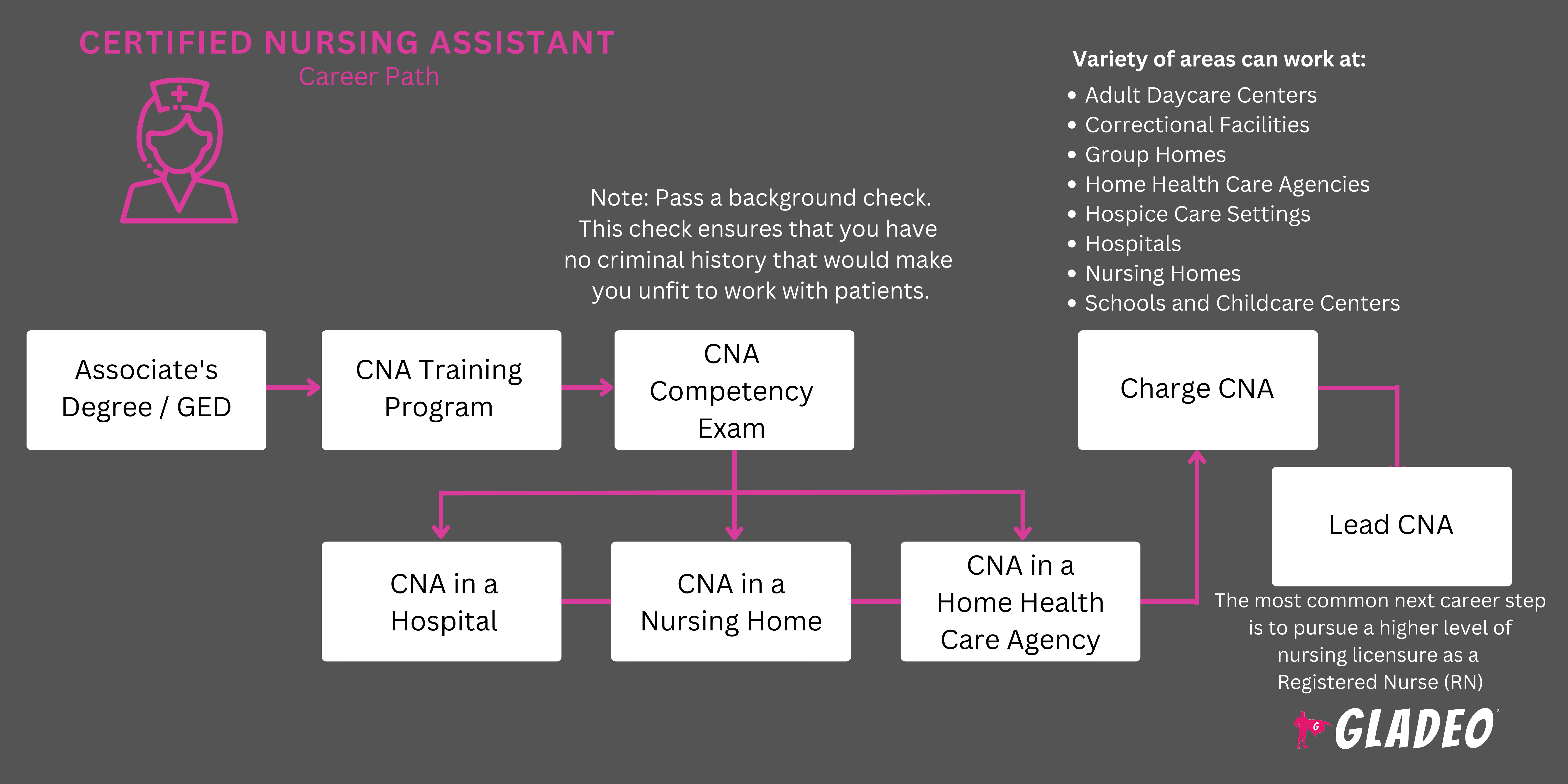Spotlights
Certified Medication Aide (CMA), Certified Nurse Aide (CNA), Certified Nurses Aide (CNA), Certified Nursing Assistant (CNA), Licensed Nursing Assistant (LNA), Nurses' Aide, Nursing Aide, Nursing Assistant, Patient Care Assistant (PCA), State Tested Nursing Assistant (STNA)
Certified Nursing Assistants (CNAs) provide essential care and support to patients in hospitals, assisted living centers, nursing homes, community-based adult day care centers, and private residences.
Also known in some states as nursing aides or assistants, CNAs bear general responsibility for ensuring clean, safe environments for patients. They work under the supervision of licensed nurses to ensure their patients’ basic needs are met, such as bathing, getting dressed, and eating.
They also monitor patient vital signs, assist with mobility, and offer much-needed companionship. Depending on their training, they may even offer limited support during medical procedures.
CNAs are vital members of the healthcare team and crucial links between patients and their nurses, recording information in charts and reporting changes so the best care can be given at all times!
- Making an impact on the health, life spans, and daily quality of life of patients
- Growing demand in the healthcare field
- Numerous opportunities for personal and professional growth
Lịch làm việc
- Certified Nursing Assistants may work part-time or full-time. Shifts may include nights, weekends, or holidays.
Nhiệm vụ tiêu biểu
CNA duties can vary by state, setting, and training. Certain duties require the direct supervision of a registered nurse.
- Assist patients with personal hygiene including bathing, grooming, dressing, and using the toilet
- Serve meals and help patients eat, recording their food and liquid intake
- Prepare rooms and bathrooms for new patients, ensuring they are tidy and sanitary. Change bedsheets and stock toiletry items
- Help patients with mobility, including transferring them between beds and wheelchairs, and repositioning for sitting or sleeping
- Monitor and record vital signs such as heart rate, blood pressure, and temperature
- Observe changes in patients’ conditions. Report changes to the supervising nurse
- Respond to patient calls and bed alarms. Care for catheters
- Provide companionship and emotional support
- Document patient information, such as responses to treatment and health concerns
- Ensure effective communication between patients and healthcare professionals
- If trained and authorized, CNAs may also:
- Assist with noninvasive medical procedures, such as dressing wounds
- Administer oral, optical, nasal, and topical medications
- Draw blood
- Collect urine or stool samples
- Transport patients to appointments
Trách nhiệm bổ sung
- Assist with laundry, errands, and appointment scheduling
- Help with discharging patients
- Collaborate effectively with patients’ larger healthcare team or caregiver agencies
- Stay up-to-date on best practices
- Assist with training new CNAs
- Help nurses set up medical equipment. Perform basic equipment cleaning
Kỹ năng mềm
- Cách cư xử bên giường bệnh
- Lòng thương
- Sự bình tĩnh
- Độ tin cậy
- Chú ý đến chi tiết
- Dexterity
- Khả năng phục hồi cảm xúc
- Cảm
- Hand-eye coordination
- Chính trực
- Kỹ năng giao tiếp
- Methodical
- Người quan sát
- Tính kiên nhẫn
- Sức bền thể chất
- Xây dựng mối quan hệ
- Độ tin cậy
- Ý thức an toàn
- Phán đoán đúng đắn
- Kỹ năng giao tiếp mạnh mẽ
- Làm việc nhóm và cộng tác
- Quản lý thời gian
Kỹ năng kỹ thuật
- Basic medical knowledge, including medical terminology, taking vital signs, and patient care techniques
- Knowledge of medical illnesses and injuries, and their signs and symptoms
- General familiarity with healthcare equipment and technology
- Knowledge of hygiene, sterilization practices, and infection control practices
- Proficiency in documenting and maintaining patient records using medical records software
- Familiarity with the roles of other medical professionals
- Các trung tâm hỗ trợ sinh hoạt
- Community-based adult day care centers
- Cộng đồng hưu trí chăm sóc liên tục
- Cơ sở chăm sóc giảm nhẹ
- Hospitals and clinics
- Cơ sở chăm sóc điều dưỡng (cơ sở điều dưỡng có tay nghề)
- Viện dưỡng lão và cơ sở chăm sóc dài hạn
- Outpatient care centers
- Private residences
- Trung tâm phục hồi chức năng
Certified Nursing Assistants are entrusted with the welfare of patients who are often vulnerable due to age, illness, or disability. They frequently assist multiple patients on any given day, thus requiring strong organizational and prioritization skills.
The work can be both physically demanding and emotionally taxing, with schedules sometimes requiring night, weekend, and holiday shifts. CNAs must stay vigilant, empathetic, and patient to ensure their patients receive the best care possible even during stressful or tiring circumstances. In addition, they should take time to practice self-care in order to avoid job burnout or feelings of detachment.
The nursing field in general has faced a critical shortage in recent years. This is due to a combination of factors, including an increase in life expectancy causing people to require more years of the healthcare services of nurses and CNAs.
In turn, this has created a bottleneck situation, as there are not enough nursing faculty available to train new nurses and CNAs to replace retiring ones. Meanwhile, as the workload continues to stack up, extra strain is placed on nursing professionals who must find ways to manage their own mental well-being and work-life balance.
CNAs may have always had an interest in helping others. They could have been involved in caregiving roles from a young age with infirm family members. They tend to have a natural compassion and a desire to make a tangible difference in other people’s lives!
Giáo dục cần thiết
As a reminder, not every state uses the title Certified Nursing Assistant (CNA). Some simply use the terms Nursing Assistant or Nursing Aide.
- To become a Certified Nursing Assistant requires completing a state-approved CNA training program through an accredited school
- Note, applicants will need a high school diploma or equivalent. However, some high schools feature CNA programs for juniors and seniors
- CNA training programs are widely available at community colleges, vocational/technical schools, and even in some hospitals and nursing homes
- “A typical CNA program lasts for about 120 hours or six weeks and includes four weeks in a classroom and two weeks in a clinical setting,” writes Indeed. “Many online CNA programs can accommodate a variety of student schedules and may offer classes during the day and on evenings and weekends.”
- Course topics include:
- Human anatomy
- Infection control
- Medical terminology
- Nutrition
- Patient rights
- Safety and emergencies
- Vital signs
- Practical training includes instruction on basic nursing principles along with RN-supervised caregiving experiences in clinical settings—usually “at least 75 hours of practical experience in an accredited CNA training facility, which also includes at least 16 hours of supervised clinical and 16 hours of laboratory training.” However, some states may require up to 175 hours of training
- Additional state-specific and employer-specific training requirements vary
- Note, upon completion of a state-approved program, students are required to pass a competency exam to obtain a certification or qualify for a state-issued license
- Many states use the National Nurse Aide Assessment Program exam for this. Others have their own exams
- Exams usually consist of a written or oral test proctored through a third party, featuring multiple-choice questions. There is also a clinical skills portion where test-takers demonstrate proficiency in various tasks
- Certification is usually good for two years, and renewable based on state or employer-specific requirements (such as completing continuing education or maintaining employment)
- In addition to the above, CNA hopefuls may need to verify or update their immunizations (such as seasonal Influenza vaccination, tetanus, diphtheria, and pertussis (Tdap), measles, mumps, and rubella (MMR), hepatitis B, varicella, and meningococcal)
- They may also have to pass criminal background and drug screenings
- CNAs may complete optional credentials, such as:
- American Board of Wound Management’s Certified Wound Care Associate
- American Council on Exercise’s Functional Training Specialty Certification
- American Medical Certification Association’s Patient Care Technician Certification
- American Phlebotomy Association’s Patient Care Technician
- American Red Cross Basic Life Support Certification
- Certified Medication Assistant (CMA)
- Hospice and Palliative Nurses Association’s Certified Hospice and Palliative Nursing Assistant
- National Association for Practical Nurse Education and Service’s Intravenous Therapy Certification
- National Center for Competency Testing’s Nationally Certified Patient Care Technician
- National Certification Board for Alzheimer Care’s Certified Alzheimer Caregiver
- National Council of State Boards of Nursing’s National Nurse Aide Assessment Program
- National Healthcareer Association’s Certified Patient Care Technician/Assistant
- Rehabilitation Engineering and Assistive Technology Society of North America’s Seating and Mobility Specialist
CNA training programs are available at community colleges, vocational/technical schools, some hospitals and nursing homes, and even through some high school programs.
- Review the exact training and certification/licensure requirements for the state you plan to work in.
- Cân nhắc chi phí học phí (mức học phí trong tiểu bang/ngoài tiểu bang), chiết khấu, học bổng và các lựa chọn hình thức học (tại trường, trực tuyến hoặc chương trình kết hợp).
- Look for accredited programs with strong reputations and high pass rates for state certification exams.
- Review the available options for hands-on training in local healthcare settings.
- Consider the duration of the program and the flexibility of class schedules, especially if balancing other commitments.
- Xem lại tiểu sử và giải thưởng của giảng viên. Tìm hiểu về tỷ lệ tốt nghiệp và số liệu thống kê việc làm. Khám phá những thành tựu của mạng lưới cựu sinh viên!
- Làm tình nguyện tại các cơ sở chăm sóc sức khỏe để có cơ hội tiếp xúc và học hỏi các kỹ năng thực tế
- Take classes in high school related to anatomy, physiology, biology, health sciences, and first aid
- Earn good grades so you can get accepted into a suitable CNA training program
- Participate in school activities where you can hone your soft skills and gain leadership experience
- Think about the format you want to take CNA classes in. Some topics are fine for online study, but others need to be learned in person
- Research the CNA certification requirements for your state. Keep in mind that you may have to pass a criminal background check or drug screening
- Request to do an informational interview with a working CNA to learn about their daily duties
- Check out online articles and videos about the career field, the various settings you could work in, and extra certifications you may want to pursue!
- Duy trì danh sách liên lạc (có số điện thoại hoặc email) có thể làm người tham khảo cho công việc trong tương lai
- Giữ một bản nháp sơ yếu lý lịch của bạn và cập nhật nó khi bạn có thêm kinh nghiệm
- Develop a workout schedule so you can stay in shape and manage stress

- Once certified to work in their respective states, CNAs can explore job postings via sites like Indeed, Glassdoor, myCNAjobs, healthcare-specific job search sites, and the websites of applicable employers (i.e., assisted living centers, adult day care centers, hospitals, clinics, nursing care facilities, etc.)
- Note, many recruiters have established pipelines with local CNA training programs, so talk to your school’s program manager or career center about job placement assistance
- Network with fellow healthcare professionals to learn about job opportunities. Don’t underestimate the power of “word of mouth” recruiting!
- Hãy quảng cáo bản thân trên LinkedIn và duy trì sự chuyên nghiệp trên mạng xã hội. Các nhà tuyển dụng tiềm năng thường xuyên kiểm tra các hoạt động trực tuyến của ứng viên.
- Check out Certified Nursing Assistant resumes for ideas on formatting, phrasing, and keywords to use
- Review potential interview questions to expect. Do several mock interviews to practice your responses
- Exhibit a hearty and nurturing attitude that conveys your ability to physically and mentally handle the workload
- Read about the strategies recruiters use, to gain a perspective of their mindset during interviews
- Ăn mặc chuyên nghiệp khi phỏng vấn
- Let your supervisor know your career goals and ask for their advice and mentorship
- Build a reputation for providing outstanding patient care. Master your bedside manner and follow instructions carefully
- Establish clear communications with patients, nurses, and other healthcare team members
- Keep learning! Stay up-to-date on best practices regarding patient care related to CNA duties
- Be diligent when it comes to sanitation and hygiene
- Pursue further education and training opportunities to learn new skills and competencies
- Consider becoming a licensed practical nurse or registered nurse
- Learn all relevant employer policies and procedures
- Study manufacturer and software guides for equipment and programs you use frequently
- Demonstrate top-notch leadership capabilities and patiently train and mentor younger professionals
- Stay engaged with professional organizations. Attend events, hold committee posts, and actively work to advance your reputation
Trang web
- Hiệp hội chăm sóc sức khỏe Hoa Kỳ
- American Journal of Nursing
- Hiệp hội Y tá Hoa Kỳ
- Commission on Collegiate Nursing Education
- Critical Care Nurse
- International Journal of Nursing Practice
- Tạp chí Chất lượng Chăm sóc Điều dưỡng
- Tạp chí Giáo dục Điều dưỡng
- Journal of Professional Nursing
- Tạp chí của Hiệp hội Lão khoa Hoa Kỳ
- MEDSURG Nursing
- Hiệp hội quốc gia về chăm sóc tại nhà và chăm sóc giảm nhẹ
- Hiệp hội quốc gia về giáo dục và dịch vụ điều dưỡng thực hành
- National Association of Health Care Assistants
- Trung tâm Kiểm tra Năng lực Quốc gia
- Hội đồng Chứng nhận Quốc gia về Chăm sóc Bệnh Alzheimer
- Hội đồng Quốc gia của Hội đồng Điều dưỡng Nhà nước
- Hiệp hội chăm sóc sức khỏe quốc gia
- Nursing Assistants Online
- Nursing Ethics
- Nursing Made Incredibly Easy
- Nursing Science Quarterly
- Tiêu chuẩn điều dưỡng
- The Gerontologist
Sách vở
- CNA Study Guide 2023-2024 Edition, by Gerald Sackler
- Mosby’s Essentials for Nursing Assistants, by Leighann Remmert MS RN, and Sheila A. Sorrentino PhD RN
- Nursing Assistant: A Nursing Process Approach, by Barbara Acello and Barbara Hegner
The day-to-day work life of a CNA can be rewarding but often challenging. It’s a critically important career field and frequently serves as a valuable stepping stone for advanced opportunities, as well.
But it’s not everyone’s cup of tea—and that’s okay! There are dozens of exciting healthcare careers to explore. Below are just a few of the most popular ones to consider:
- Dental Assistant
- Trợ lý Y tế tại Nhà
- Licensed Practical Nurse (LPN)
- Medical Assistant
- Y tá gây mê
- Y tá hộ sinh
- Trợ lý trị liệu nghề nghiệp
- Optometrist Assistant
- Physical Therapy Assistant
- Physician Assistants
- Registered Nurse (RN)
- Veterinarian Assistant
Nguồn cấp tin tức

Công việc nổi bật

Các khóa học và công cụ trực tuyến

Kỳ vọng về mức lương hàng năm
New workers start around $39K. Median pay is $41K per year. Highly experienced workers can earn around $48K. Median pay is ABOVE LIVING WAGE.
# Số lượng việc làm mở hàng năm

There are 99930 annual job openings due to growth and turnover in this career. Jobs in this field are projected to grow over the next 5 years.







